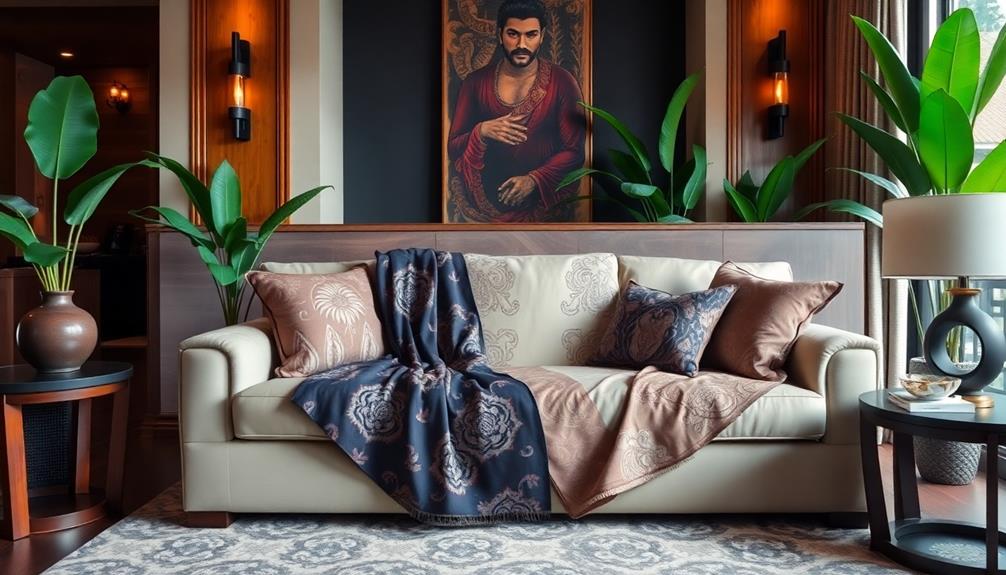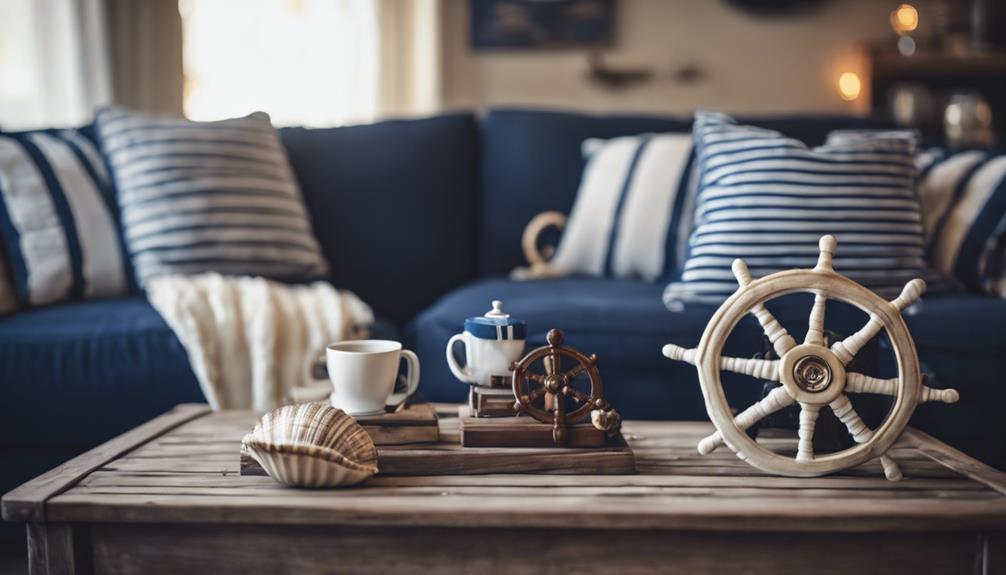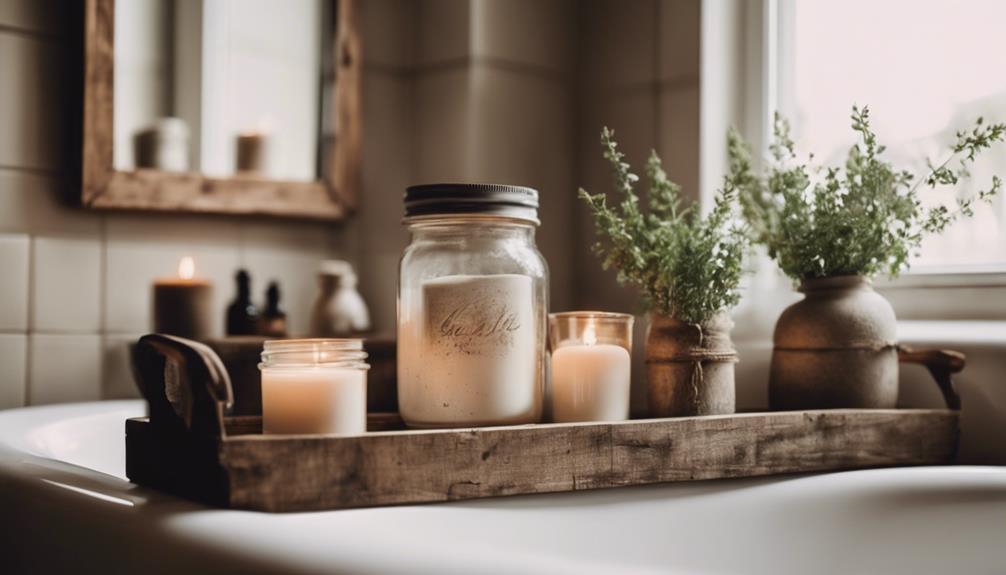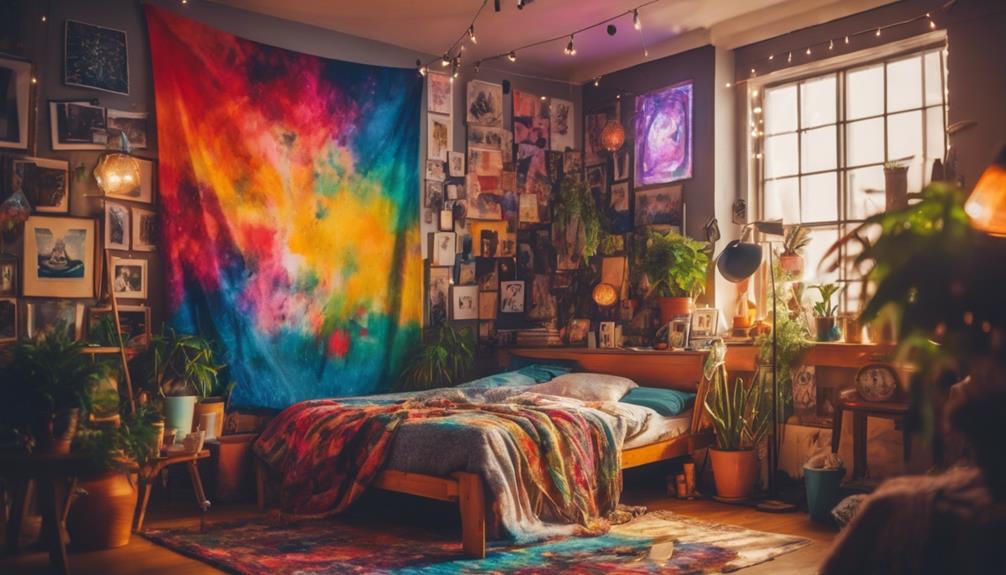To achieve a high-end look in your home, consider incorporating ikat textiles. These stunning Indonesian fabrics feature intricate, vibrant patterns created through a labor-intensive dyeing technique, adding rich cultural heritage to your space. Whether you choose throw pillows, curtains, or upholstered furniture, ikat's unique aesthetic elevates any decor style. Plus, each piece tells a story linked to its artisan, enhancing its charm. When you select ikat, look for quality craftsmanship to guarantee durability and visual impact. Embrace the beauty of these textiles, and you'll discover even more ways to transform your home into a luxurious retreat.
Key Takeaways
- Incorporate vibrant ikat textiles into home decor for a striking and culturally rich aesthetic.
- Use ikat fabrics for statement pieces like throw pillows or reupholstered furniture to enhance visual interest.
- Select high-quality ikat pieces that reflect traditional craftsmanship for durability and authenticity.
- Understand the cultural significance of ikat patterns to appreciate their artistic heritage in your decor.
- Explore local artisan markets or online platforms for unique ikat textiles that support traditional craftsmanship.
Understanding Ikat Technique
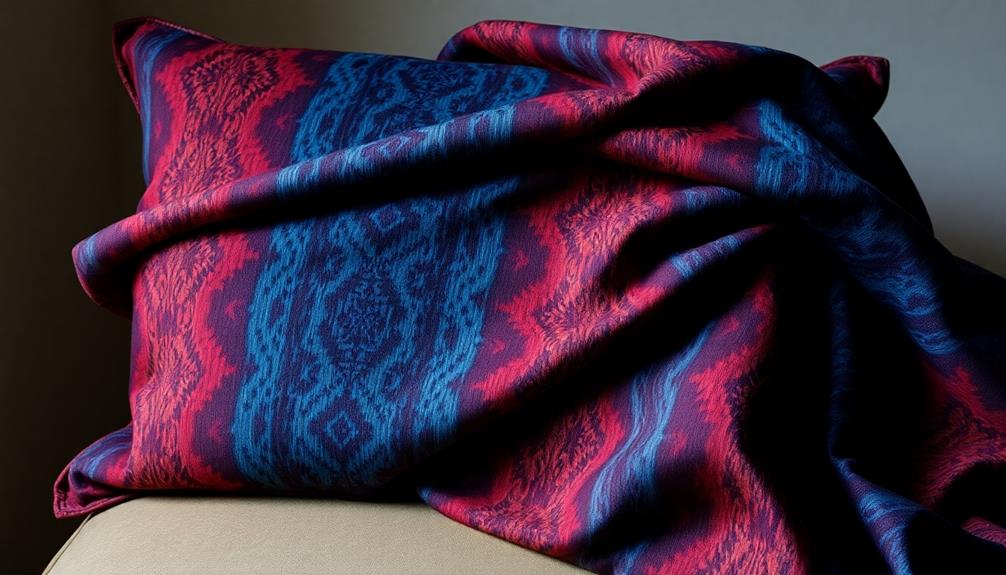
While you may have admired beautiful textiles, understanding the ikat technique reveals the artistry behind them. This traditional Indonesian method involves dyeing threads before weaving, resulting in intricate patterns that often have a unique blurred effect.
The alignment of warp and weft threads is essential; even a slight misalignment can distort the design during the weaving process, showcasing the artisan's precise craftsmanship. Additionally, the ikat technique embodies a rich cultural heritage, much like the Face Indonesian Decor Mask which highlights traditional craftsmanship.
In double ikat, both warp and weft threads undergo dyeing, making it a more complex and challenging form of the technique. This complexity requires exceptional skill to maintain pattern continuity throughout the final piece.
Artisans typically combine solid color warps with patterned warps, adding layers of visual richness to the textile. The ikat technique also features a circular warp, which creates small un-woven gaps, ensuring that every piece is distinct and reflects the artisan's unique style.
The Unique Aesthetic of Ikat
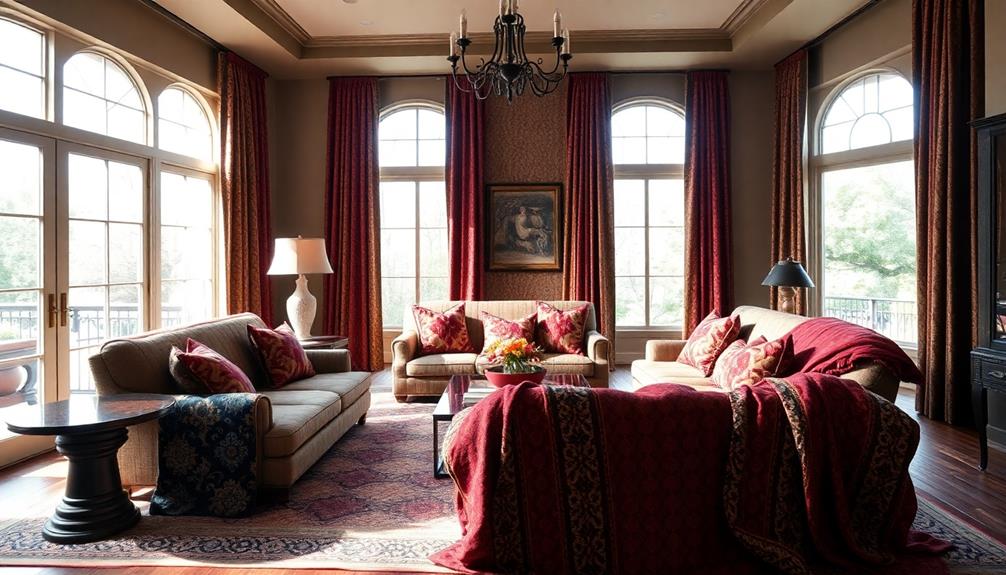
Ikat's unique aesthetic captivates with its vibrant colors and intricate patterns, making each piece a work of art. This distinctive textile art employs traditional methods of tying and dyeing threads before weaving, resulting in stunning designs that often appear blurred or softened.
The technique is primarily categorized into Warp Ikat and Weft Ikat, each producing different visual effects that add depth and character to the fabric. Additionally, the use of ikat in Indonesian Decorative Pillows enhances living spaces, reflecting cultural heritage while providing comfort.
Double ikat stands out as a particularly complex form, where both warp and weft threads are dyed. This meticulous process requires precise alignment during weaving to maintain the intended patterns, showcasing the artisan's exceptional skill. The alignment of threads is essential; any misstep can disrupt the imagery, highlighting the craftsmanship involved.
Ikat textiles aren't just visually striking; they also carry cultural significance. Different regions produce unique motifs that tell stories and reflect local traditions.
Historical Significance of Ikat
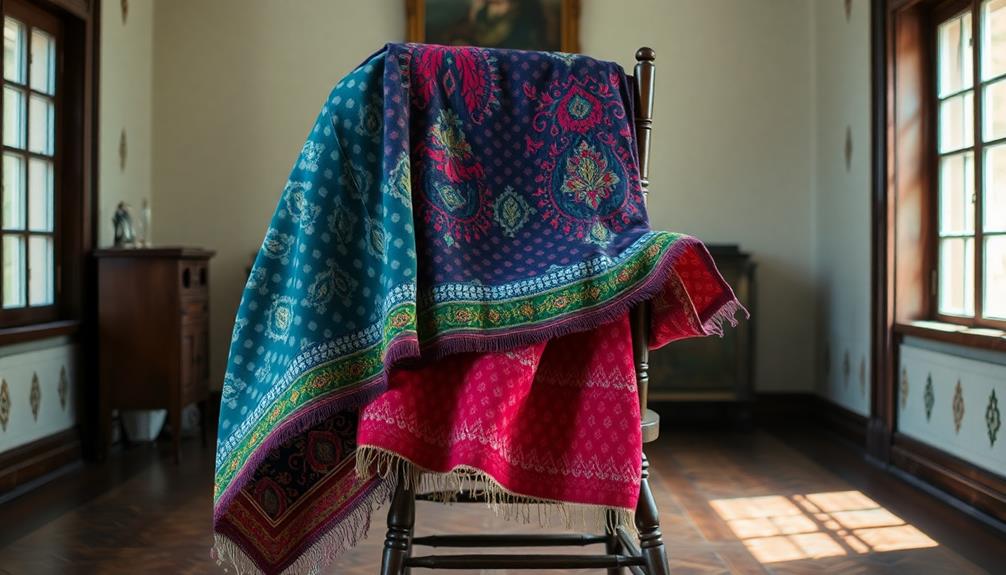
When you explore ikat, you're not just looking at stunning textiles; you're uncovering layers of cultural heritage and identity woven into each piece.
The intricate patterns reflect deep symbolism and the complex weaving techniques that have been refined over generations, much like the traditional Indonesian style home decor that incorporates natural materials and harmony with nature.
Understanding this art form enriches your appreciation for its role in Indonesian society and tradition.
Cultural Heritage and Identity
Ikat represents more than just a textile; it embodies Indonesia's rich cultural heritage and identity. When you explore ikat, you're not just admiring beautiful fabrics; you're witnessing traditional weaving techniques that have been passed down through generations.
Each piece reflects the cultural identity of the community that created it, with intricate patterns and colors often linked to specific rituals and social statuses. The vibrant artistry of these textiles can be paralleled with the stunning designs found in Indonesian decor masks, further enhancing the appreciation of cultural craftsmanship.
In places like Tenganan, Bali, the double ikat technique showcases the artisan's skill, requiring precise alignment of warp and weft threads. This complexity highlights not only the artistry involved but also the historical significance of the craft.
As you wear or display an ikat textile, you carry a symbol of resistance against globalization, preserving traditional techniques amid modern influences.
Weaving Techniques and Complexity
Mastering ikat weaving involves a meticulous process that showcases the artisan's skill and dedication. This complex technique requires you to tie-dye threads before weaving, ensuring precise alignment to maintain the intended patterns and imagery.
You'll find two primary forms of ikat: Warp Ikat, where the warp threads are dyed beforehand, and Weft Ikat, where the weft threads receive the dye. Each method produces distinct visual effects in the final textile.
Additionally, the cultural significance of housing in Indonesia often reflects similar intricate craftsmanship, as seen in the traditional Indonesian housing styles that vary by region. Among these, double ikat stands out as the most intricate form, as it requires both warp and weft threads to be dyed. Achieving the desired design demands exceptional skill and accuracy from you as the weaver.
To facilitate effective lifting during the weaving process, heddles are created for every four threads, allowing you to craft intricate patterns with ease.
The historical significance of ikat in Indonesia is profound, particularly in regions like Tenganan in Bali, where unique double ikat textiles reflect rich cultural heritage.
Symbolism in Patterns
Through intricate weaving, Indonesian ikat textiles embody rich symbolism that resonates with the weaver's community. The patterns you see aren't just aesthetic; they carry deep cultural meanings, often tied to local myths, legends, and social status. Each design reflects the identity of the community, showcasing a unique art form steeped in tradition.
The alignment of threads in ikat weaving is essential for maintaining these intricate imagery during the process. Different warps signal various projects, with unique tying methods that demonstrate the weaver's skill and heritage. The double ikat technique, where both warp and weft threads are dyed, is especially rare and complex. This technique is often reserved for ceremonial textiles, highlighting the artisan's mastery and cultural significance.
Moreover, ikat textiles serve purposes beyond decoration. They play significant roles in rituals and ceremonies, symbolizing protection, prosperity, and cultural pride within Indonesian communities.
Ikat in Modern Decor
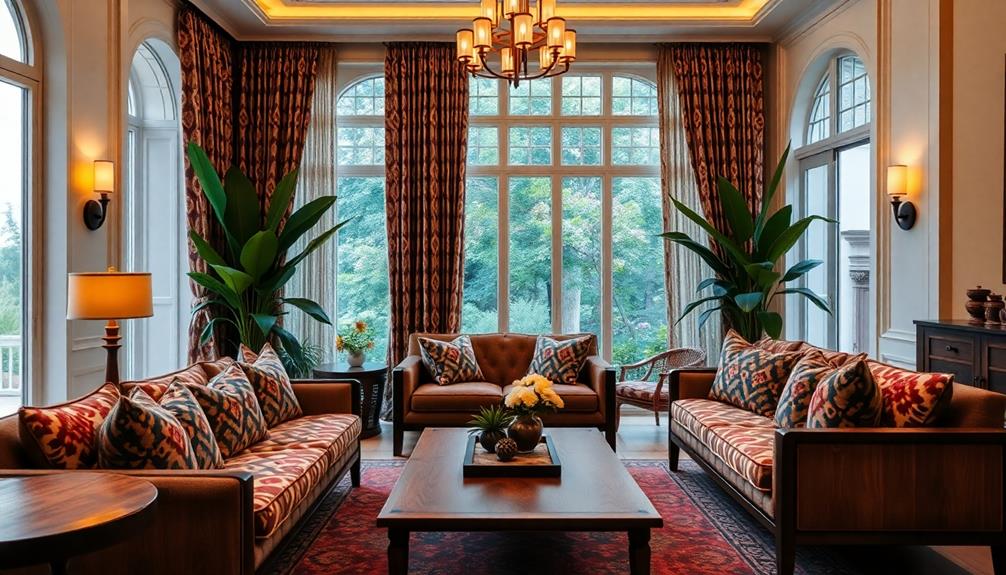
When you incorporate ikat textiles into your modern decor, you're not just adding fabric; you're infusing your space with a rich cultural heritage and stunning artistry.
These textiles, known for their intricate patterns achieved through a unique dyeing process, can transform any room into a visual masterpiece. The double ikat technique, especially from regions like Tenganan in Bali, showcases meticulous craftsmanship, making these pieces rare finds that elevate your interior design.
Ikat fabrics bring a layer of sophistication and vibrancy, serving as striking statement pieces that complement various styles. Whether you use them for upholstery, throw pillows, or curtains, their versatility allows you to maintain a luxurious aesthetic while embracing contemporary design.
The growing trend of blending traditional ikat designs with modern elements makes it a favorite among interior designers. This fusion creates unique, high-end spaces that reflect a rich cultural heritage, making your home not just a living space, but a canvas of artistry.
How to Select Ikat Fabrics
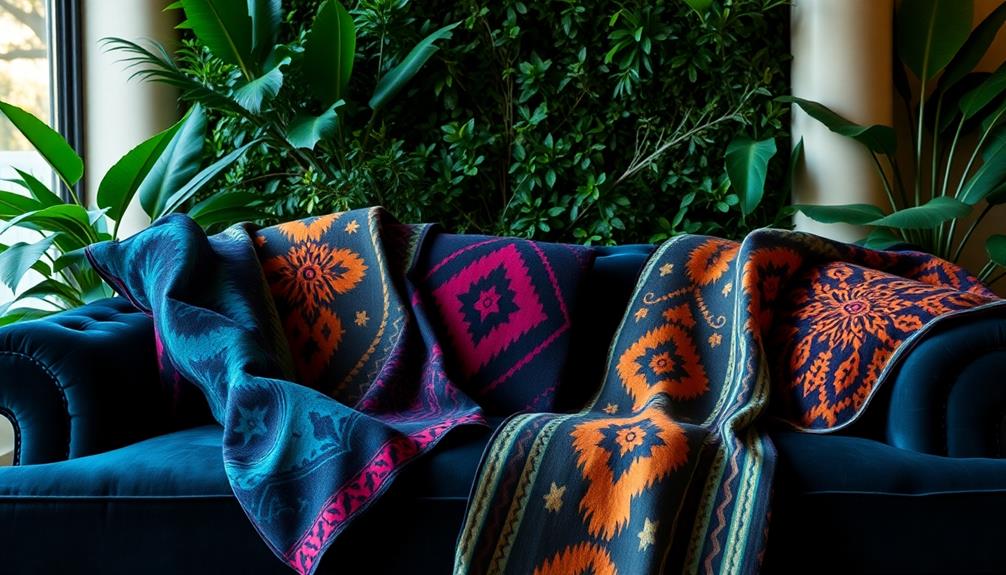
Selecting ikat fabrics for your decor can be an exciting yet nuanced process. Start by looking for double ikat styles, which showcase intricate tie-dyeing of both warp and weft threads. This technique results in complex, visually stunning patterns that elevate your space.
Next, pay attention to the precision alignment of the ikat threads. Proper alignment is essential for maintaining the integrity of the imagery during the weaving process, guaranteeing the fabric looks flawless.
Consider the weight and texture of the fabric as well. High-quality ikat fabrics are often made from silk or fine cotton, offering a luxurious feel that enhances your decor. To maintain that high-end look, check for colorfastness by testing the fabric with water. This will help you verify that the vibrant colors won't bleed, preserving the beauty of the ikat design.
Lastly, opt for fabrics from regions renowned for their ikat craftsmanship, like Tenganan in Bali. This choice assures authenticity and supports local artisans, adding a meaningful touch to your decor.
Incorporating Ikat in Home Design
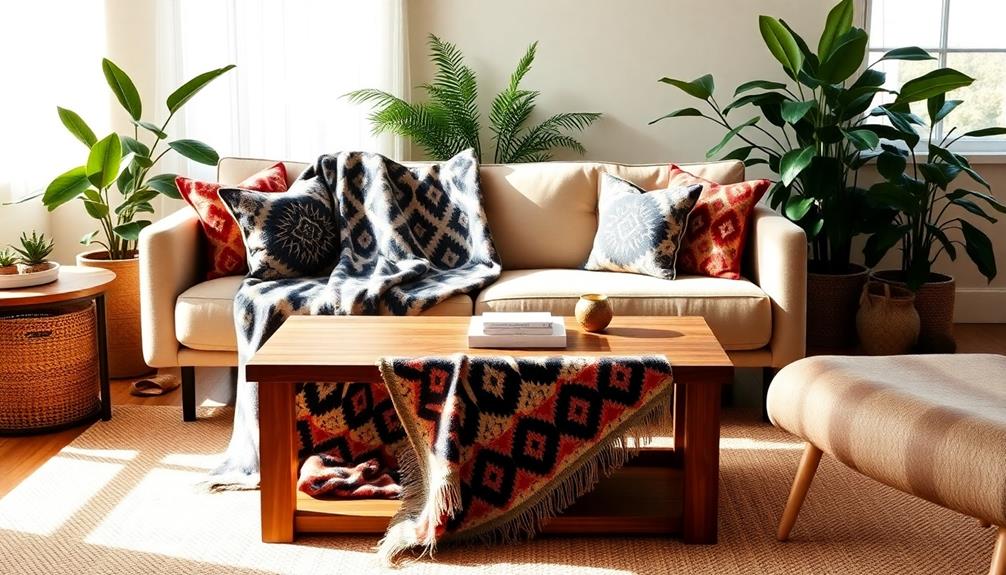
Incorporating ikat textiles into your home design can transform your space with their vibrant colors and unique patterns.
These textiles not only showcase rich cultural heritage but also add a touch of sophistication to any room. By using ikat in various applications, you can create a visually appealing atmosphere that's both functional and stylish.
Here are some ways to incorporate ikat textiles effectively:
- Throw Pillows: Add vibrant ikat throw pillows to your sofa for a pop of color and texture.
- Curtains: Use ikat curtains to frame your windows, bringing in light while showcasing intricate patterns.
- Upholstery: Reupholster an accent chair or ottoman with ikat fabric to create a statement piece.
- Feature Wall: Consider creating a feature wall with ikat fabric, making it a focal point in the room.
Care and Maintenance of Ikat Textiles
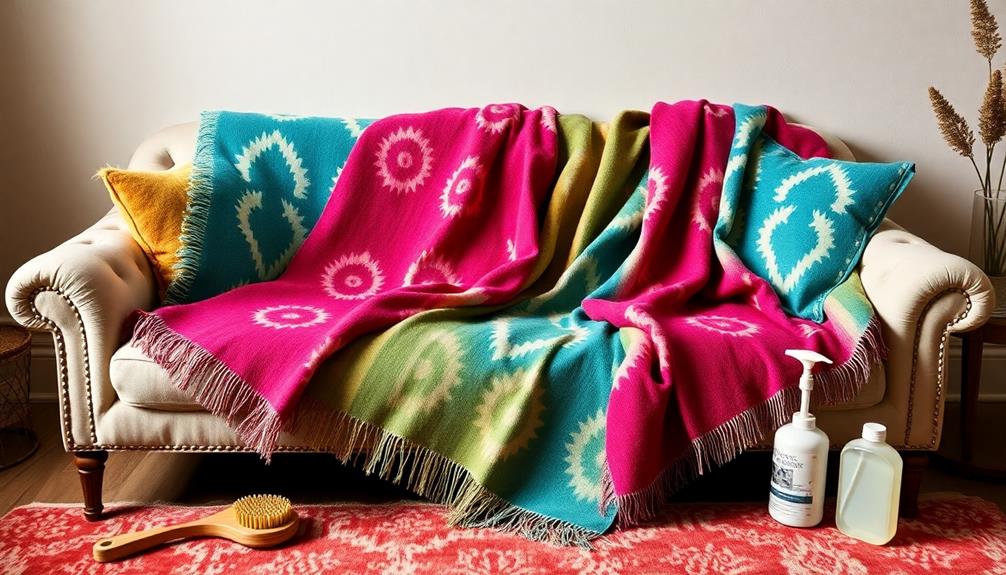
Adding ikat textiles to your home can greatly elevate your design, but keeping them looking their best requires proper care and maintenance. To preserve the vibrancy of the colors, hand-wash your ikat fabrics in cold water with a mild detergent. This helps prevent fading or bleeding of dyes.
Avoid exposing these textiles to direct sunlight for extended periods, as UV rays can deteriorate the beautiful hues over time.
When it comes to ironing, always use a low heat setting. Place a cloth between the iron and the fabric to protect the delicate fibers and maintain the integrity of the patterns.
For storage, keep your ikat pieces in a cool, dry place, ideally rolled rather than folded. This prevents creasing and helps maintain their shape and design.
It's also a good idea to regularly check for signs of wear or damage. Address any issues like loose threads or fraying promptly to guarantee the longevity of the textile.
With these simple care and maintenance practices, your ikat textiles can remain stunning and high-end for years to come.
Regional Variations of Ikat
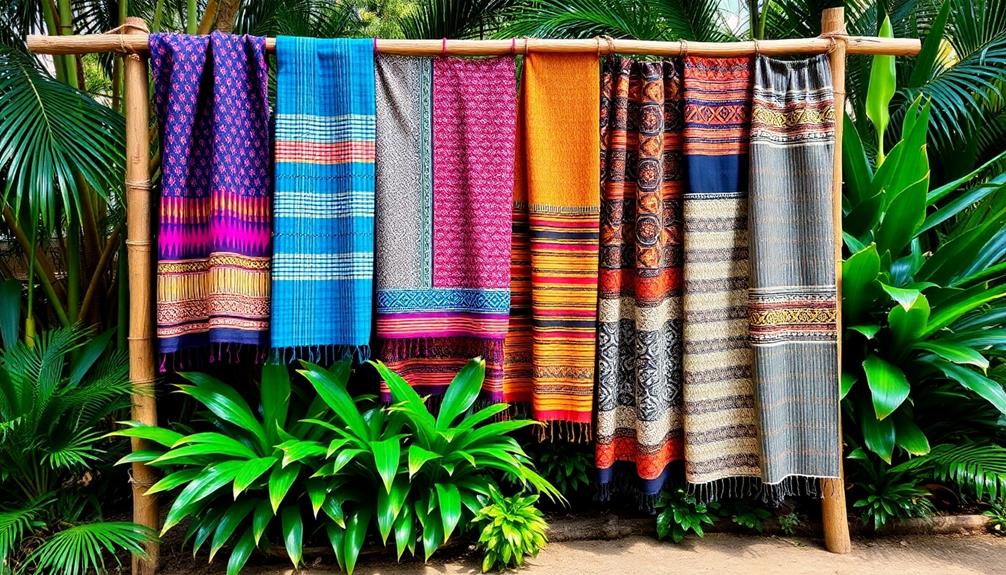
When you explore the regional variations of ikat, you'll notice how traditional techniques differ from contemporary applications.
Each area in Indonesia brings its own flair, whether it's Sumba's bold designs or Bali's intricate double ikat.
Understanding these distinctions can enrich your appreciation of this unique textile art.
Traditional Ikat Techniques
Often celebrated for their intricate beauty, traditional ikat techniques showcase the rich diversity found across Indonesia's regions. The artistry lies in the precise tying and dyeing of threads before weaving.
You'll notice two primary forms of ikat: warp ikat, where the warp threads are dyed beforehand, and weft ikat, where the weft threads are treated instead. Each method offers unique patterns and textures.
Here are some key aspects of traditional ikat techniques:
- Double Ikat: This intricate method requires both warp and weft threads to be dyed, demanding exceptional precision during weaving.
- Cultural Identity: Each textile tells a story, reflecting the traditions and practices of the artisan's community.
- Regional Variations: Different areas showcase distinct styles, colors, and motifs, such as the renowned double ikat textiles from Tenganan, Bali.
- Artistic Expression: These textiles serve as more than just fabric; they embody the heritage and artistry of Indonesian communities.
Embracing these traditional ikat techniques not only elevates your wardrobe but also connects you to the rich tapestry of Indonesian culture.
Contemporary Ikat Applications
Traditional ikat techniques have found new life in contemporary applications, showcasing the vibrant regional variations that define Indonesian textiles today. You'll notice how contemporary ikat blends tradition with modern design, particularly in areas like Sumba, Flores, and Bali. Each region brings unique patterns and dyeing methods that reflect its culture.
One standout technique is double ikat from Tenganan village in Bali, where both warp and weft threads are dyed before weaving. This meticulous process not only highlights the area's craftsmanship but also results in stunning, intricate patterns. Designers are increasingly incorporating these textiles into high-end fashion and home decor, achieving a luxurious and artisanal quality.
Here's a look at some regional variations in contemporary ikat:
| Region | Characteristics |
|---|---|
| Sumba | Bold colors, geometric patterns |
| Bali | Intricate designs, subtle hues |
| Flores | Natural motifs, earthy color palettes |
| Tenganan | Double ikat, complex patterns |
These contemporary ikat designs are made with precision, showcasing the time and skill of artisans. Embracing these variations adds depth and exclusivity to your style.
Artisan Stories Behind Ikat
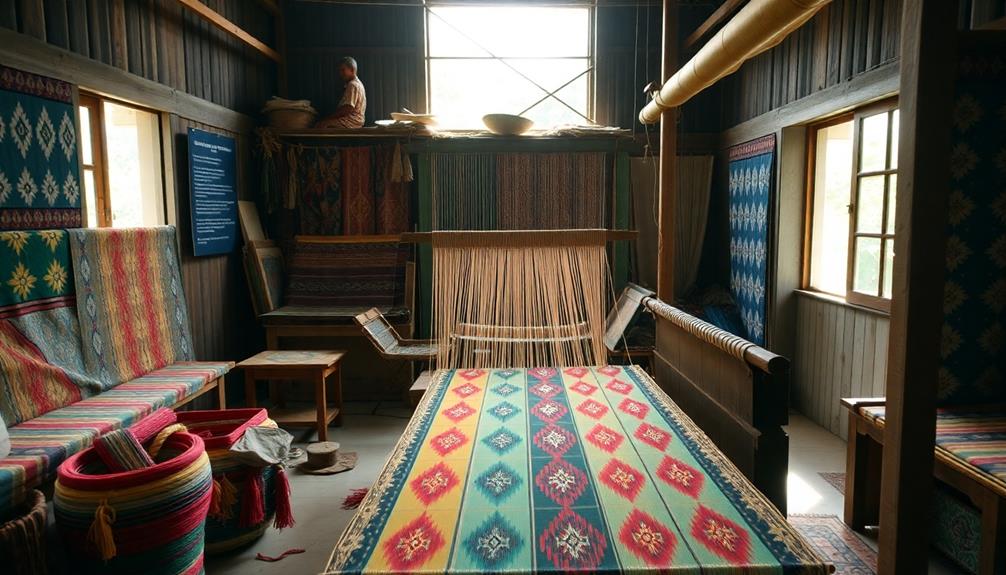
Ikat textiles embody a rich tapestry of stories, woven through generations of artisan skill and cultural pride. Each piece isn't just a product but a narrative that connects you to the artisans who dedicate their lives to this intricate craft.
The process is labor-intensive, especially in Tenganan, Bali, where artisans like Ni Luh Suryati may spend up to a year creating a single double ikat piece. This meticulous effort guarantees the integrity of the intricate patterns, essential for producing high-quality textiles.
Consider these aspects of ikat weaving:
- Time-Consuming Techniques: Double ikat requires precise alignment and dyeing of both warp and weft threads.
- Cultural Heritage: Tenganan village has preserved its weaving traditions for over a millennium.
- Artisan Dedication: Each piece reflects the artisan's commitment to their craft and community.
- Identity Representation: Ikat textiles serve as a symbol of the artisans' cultural identity and history.
These artisan stories enrich each ikat piece, making it far more than just a textile; it's a connection to the past and a celebration of craftsmanship.
Where to Buy Ikat Pieces
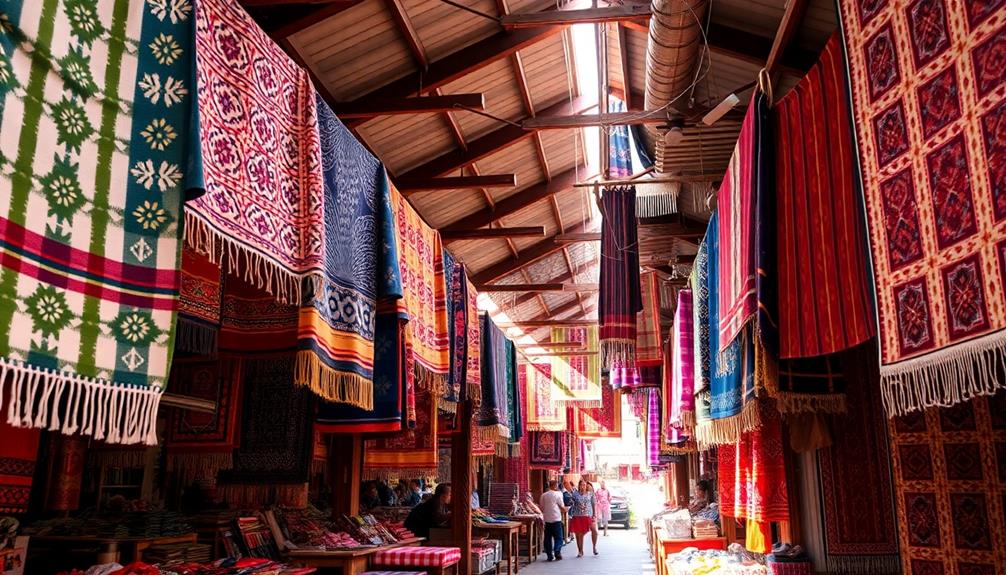
When you're on the hunt for authentic ikat pieces, local artisan markets in Bali are a fantastic starting point.
You can also explore online textile stores and cultural heritage shops that showcase these unique textiles.
Each option offers a chance to find beautiful, handcrafted items while supporting traditional craftsmanship.
Local Artisan Markets
If you're looking to discover authentic ikat pieces, the artisan markets in Tenganan village offer a unique shopping experience. Known for its double ikat weaving, this village showcases the meticulous craftsmanship that can take about a year to complete.
By visiting local markets, you gain direct access to handcrafted ikat textiles, allowing you to purchase stunning pieces straight from the artisans themselves.
Here are a few things you can expect when exploring Tenganan's markets:
- Variety: From clothing to accessories and home decor, there's something for everyone.
- Vibrant Colors: Each piece features intricate patterns and bright colors that reflect the region's culture.
- Artisan Interaction: Engage with local weavers to learn about the cultural significance and techniques behind ikat production.
- Scenic Journey: The 4km dirt road from Candidasa to Tenganan adds to the charm of your textile adventure.
Visiting these local artisan markets not only supports the artisans' livelihoods but also enriches your understanding of Indonesia's textile heritage.
Online Textile Stores
In today's digital age, finding authentic ikat pieces is easier than ever with a variety of online textile stores at your fingertips. Platforms like Etsy and Amazon showcase a wide selection of ikat textiles, featuring vibrant patterns and unique craftsmanship that truly stand out.
If you want to support local artisans, check out Tenganan's official site, where you can purchase authentic double ikat textiles directly from the creators, ensuring your money goes to preserving cultural heritage.
For stylish home decor, retailers like Anthropologie and West Elm often incorporate ikat designs into their collections, providing high-end options for your space.
If you're looking for ethically sourced items, The Ikat Project offers a curated selection of handmade textiles that highlight the artistry of Indonesian weavers. You can also explore online marketplaces like eBay and Alibaba for rare and vintage ikat pieces, allowing you to discover diverse styles and historical significance.
With just a few clicks, you can find beautifully crafted ikat textiles that not only enhance your aesthetic but also promote sustainable practices like block printing and support the artisans behind these stunning creations.
Cultural Heritage Shops
Exploring cultural heritage shops in Tenganan is a must for anyone seeking authentic ikat textiles that embody the rich traditions of Indonesia. Known for its exquisite double ikat textiles, Tenganan offers a unique glimpse into the artistry of local artisans.
When you visit, you'll find a variety of authentic pieces reflecting the community's craftsmanship and cultural significance.
Here's what you can expect:
- Guided Tours: Local artisans often provide guided tours, showcasing the intricate process of double ikat weaving.
- Unique Pieces: Each textile can take up to a year to produce, making every piece one-of-a-kind.
- Cultural Significance: These textiles aren't just fabric; they carry deep cultural meanings and stories.
- Support Local Artisans: Buying from these shops helps preserve traditional weaving practices and supports the livelihood of local artisans.
Frequently Asked Questions
What Is the Indonesian Textile Technique?
Indonesian textile techniques like Ikat and Batik showcase your creativity. By tying and dyeing threads or using wax resist, you can create stunning patterns that reflect cultural heritage, perfect for adding unique flair to your wardrobe.
What Is the Most Famous Textile of Indonesia?
When it comes to textiles, Batik's the cream of the crop in Indonesia. This intricate wax-resist dyeing technique produces stunning patterns, showcasing rich cultural heritage and artistry that you can appreciate in every piece.
What Is the Fabric Design of Indonesia?
Indonesian fabric design features vibrant patterns through techniques like Batik, Ikat, and Shibori. You'll appreciate the intricate artistry and cultural significance behind each piece, making them perfect for adding unique flair to your wardrobe or home.
What Fabric Is Made Using an Indonesian Decorative Technique in Which Warp and or Weft Threads Are Tie Dyed Before Weaving?
You're looking at Ikat, a stunning Indonesian fabric where threads are tie-dyed before weaving. This technique creates vibrant patterns with blurred edges, showcasing the cultural heritage and craftsmanship of artisans who dedicate years to each piece.
Conclusion
Incorporating Ikat textiles into your decor can truly elevate your space. Did you know that nearly 80% of Indonesian households use Ikat in some form, showcasing its cultural significance and versatility? By selecting the right Ikat fabrics, you're not just adding a stylish touch; you're embracing a rich tradition that connects you to artisans and their stories. So, immerse yourself in the world of Ikat and let its unique beauty transform your home into a high-end sanctuary.
